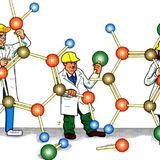On Thursday, June 13, a delegation from the Korea Basic Science Institute (KBSI) visited our institute and our NSG group. During their visit, they were briefed on our ongoing research activities. We also formulated plans to enhance our collaborative efforts in the near future.
Forwarded from IPLTI_Laboratoriya Mudirlari
First announcment_IPEC-9.pdf
125.4 KB
Forwarded from IPLTI_Laboratoriya Mudirlari
Биринчи хабарнома_IPEC-9.pdf
214.3 KB
Researchers have been developing two-dimensional materials for electronics, which are widely considered a possible replacement for silicon in future technology, promising a revolution in device performance and efficiency.
https://doi.org/10.1038/s41565-024-01693-3
https://doi.org/10.1038/s41565-024-01693-3
Nature
Projected performance of Si- and 2D-material-based SRAM circuits ranging from 16 nm to 1 nm technology nodes
Nature Nanotechnology - Simulations show that two-dimensional-material-based static random-access memory (SRAM) circuits leverage their low parasitic capacitance, counteracting performance declines...
Computational Materials Science | Journal | ScienceDirect.com by Elsevier
https://www.sciencedirect.com/journal/computational-materials-science
https://www.sciencedirect.com/journal/computational-materials-science
Rethinking materials simulations: Blending direct numerical simulations with neural operators | npj Computational Materials
https://www.nature.com/articles/s41524-024-01319-1
https://www.nature.com/articles/s41524-024-01319-1
Nature
Rethinking materials simulations: Blending direct numerical simulations with neural operators
npj Computational Materials - Rethinking materials simulations: Blending direct numerical simulations with neural operators
Atoqli arbob Anvar Zohidov tashabbusi bilan fizik, kimyoviy va biologik jarayonlarni modellashtirishni kvant kompyuterlari orqali amalga oshirish boʻyicha ilk muzokarani oʻtkazdik.
_
At the initiative of our outstanding scientist Anvar Zakhidov, we convened our first discussion on the application of quantum computers in the simulation of physical, chemical, and biological processes.
_
At the initiative of our outstanding scientist Anvar Zakhidov, we convened our first discussion on the application of quantum computers in the simulation of physical, chemical, and biological processes.
Machine learning interatomic potentials enhance atomistic modeling in materials science. Traditional methods use spherical harmonics for rotational symmetry. The authors propose Cartesian Atomic Cluster Expansion (CACE), which simplifies calculations using Cartesian coordinates. CACE incorporates chemical element embeddings, radial channel coupling, and inter-atomic message passing. It demonstrates high accuracy, stability, and generalizability, validated on systems such as bulk water, small molecules, and high-entropy alloys.
https://doi.org/10.1038/s41524-024-01332-4
https://doi.org/10.1038/s41524-024-01332-4
Nature
Cartesian atomic cluster expansion for machine learning interatomic potentials
npj Computational Materials - Cartesian atomic cluster expansion for machine learning interatomic potentials
Machine learning unlocks secrets to advanced alloys | MIT News | Massachusetts Institute of Technology
https://news.mit.edu/2024/machine-learning-unlocks-secrets-advanced-alloys-0718
https://news.mit.edu/2024/machine-learning-unlocks-secrets-advanced-alloys-0718
MIT News
Machine learning unlocks secrets to advanced alloys
An MIT team uses machine learning and computational models to measure short-range order (SRO) in high-entropy materials, unlocking the potential for designing tailored alloys with advanced properties for diverse applications.
Timelines for some important functional materials with delayed impact. The left-hand extreme of each line (in brown) shows the year of the original synthesis, while the year in which the key discovery of functionality was published is shown by a green bulb. For the cases that resulted in a Nobel Prize, the year of the prize is indicated by a red laurel. The on-going work following the key discovery is shown by the blue dots. Such on-going work is often incremental, but in some cases, it results in significant optimisations and commercial applications.
The applications of carbon nanotubes | Malvern Panalytical
https://www.malvernpanalytical.com/fr/learn/knowledge-center/insights/the-applications-of-carbon-nanotubes
https://www.malvernpanalytical.com/fr/learn/knowledge-center/insights/the-applications-of-carbon-nanotubes
Malvernpanalytical
The applications of carbon nanotubes
Tackling the biggest challenges of our time sometimes involves harnessing the power of some of the smallest particles: nanoparticles. Here we delve into the
Molecular dynamics simulation of hybrid structure and mechanical properties of DLC/Ni-DLC thin films | Scientific Reports
https://www.nature.com/articles/s41598-024-69759-9
https://www.nature.com/articles/s41598-024-69759-9
Nature
Molecular dynamics simulation of hybrid structure and mechanical properties of DLC/Ni-DLC thin films
Scientific Reports - Molecular dynamics simulation of hybrid structure and mechanical properties of DLC/Ni-DLC thin films
An Introduction to Quantum Computers and Quantum Coding | by Oliver W. Johnson | Aug, 2024 https://towardsdatascience.com/an-introduction-to-quantum-computers-and-quantum-coding-e5954f5a0415
Medium
An Introduction to Quantum Computers and Quantum Coding
Demystifying the novel world of quantum computing, quantum programming, and quantum algorithms.
Metamaterials design via and for computation | Nature Computational Science
https://www.nature.com/articles/s43588-024-00687-4
https://www.nature.com/articles/s43588-024-00687-4
Nature
Metamaterials design via and for computation
Nature Computational Science - This issue of Nature Computational Science features a Focus that highlights recent advancements, challenges, and opportunities in computational models for...
5 yillik loyihamizda ishlash uchun iqtidorli yoshlarni tanlab olishning bu yildagi kuzgi bosqichini boshladik. Bundan tashqari, boshqa loyihalar ustida ham ishlayapmiz. Tanlov davomida sizning quyidagi bilimlarni o'zlashtirish qobiliyatingiz soha mutaxassislari tomonidan baholanib boriladi:
1-bosqich: Dasturlash (programming);
2-bosqich: Fizikaviy kimyo (physical chemistry);
3-bosqich: Fizikaviy modellashtirish (computational physics).
☝️E'tibor bering! Tanlov boshida yuqoridagi bilimlarga ega bo'lishingiz talab etilmaydi. Boshlangich talab faqat sizning ingliz tilini bilishingiz. Tanlov davomida deyarli barcha adabiyotlar ingliz tilida beriladi.
Tanlovdan o'tsangiz sizda:
* Yuqori malakali mutaxassislar yordamida magistrlik ishi qilish imkoniyati;
* Sayyoramizdagi dolzarb muammolar bo'yicha PhD qilish imkoniyati;
* Rivojlangan davlat oliygohlari bilan hamkorlikda tashkil etiladigan double-PhD bo'lish imkoniyati paydo bo'ladi.
Tanlov-darslar zoom platformasi orqali olib boriladi. Tanlovning 1-bosqichida ishtirok etishni xohlaganlar o'zlarining CV (resume) larini ingliz tilida tayyorlab berishlari talab etiladi (@Ulmasoy_Turaeva).
Deadline: 30.09.2024.
1-bosqich: Dasturlash (programming);
2-bosqich: Fizikaviy kimyo (physical chemistry);
3-bosqich: Fizikaviy modellashtirish (computational physics).
☝️E'tibor bering! Tanlov boshida yuqoridagi bilimlarga ega bo'lishingiz talab etilmaydi. Boshlangich talab faqat sizning ingliz tilini bilishingiz. Tanlov davomida deyarli barcha adabiyotlar ingliz tilida beriladi.
Tanlovdan o'tsangiz sizda:
* Yuqori malakali mutaxassislar yordamida magistrlik ishi qilish imkoniyati;
* Sayyoramizdagi dolzarb muammolar bo'yicha PhD qilish imkoniyati;
* Rivojlangan davlat oliygohlari bilan hamkorlikda tashkil etiladigan double-PhD bo'lish imkoniyati paydo bo'ladi.
Tanlov-darslar zoom platformasi orqali olib boriladi. Tanlovning 1-bosqichida ishtirok etishni xohlaganlar o'zlarining CV (resume) larini ingliz tilida tayyorlab berishlari talab etiladi (@Ulmasoy_Turaeva).
Deadline: 30.09.2024.
